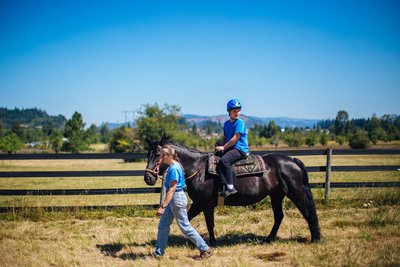
Seventeen-year-old Courtney Scott stands by the arena at a well-maintained stable in Goshen, a few miles southeast of Eugene. She’s on crutches, her left leg in a cast due to stress fractures from dancing, but her eyes sparkle as she waits for her horse to be brought out for her to ride. The crutches make her weekly ride a little more challenging, but Scott doesn’t care.
“Once I’m on it’s like I don’t have an injury,” Scott says. “I feel normal, physically and mentally. I don’t notice any difference here. Here I feel safe.”
Scott has autism, and the horse has been her favorite animal, she says, ever since she learned what animals are. She’s articulate and confident, and attributes that to RideAble, an equestrian program for people with physical or mental special needs.
“We have people on the autism spectrum, people with cerebral palsy, traumatic brain injury, PTSD — and not just veterans,” says RideAble director and lead instructor Monica Liles. “We have kids in the foster care system, so they have a lot of emotional needs. We accommodate any need but we don’t treat them special. When they’re here they’re not the person with special needs, they’re just a person.”
RideAble offers individual equestrian lessons and small group classes. With nine horses and more than 100 clients from ages 3 to 74, the riding schedule fills up fast.
Liles speaks of an 8-year-old boy with ADHD (Attention Deficit Hyperactivity Disorder) who rides three times a week. His father is amazed at how calm he is when he’s on the horse. She mentions a child in a wheelchair. In the chair he doesn’t do much, but on the horse he’s moving around, hearing people’s voices, seeing birds, turning his head.
“They want to be around the horses and they want it so badly they’re willing to work really hard,” Liles says.
RideAble’s clients can’t ride anywhere else because of liability issues. The clients get one-on-one attention and are always with a trainer. Four years ago, Scott sought activities through a program for children without fathers, but they wouldn’t help her because of her autism and ADHD. They recommended RideAble, and she’s been coming weekly ever since.
“RideAble has helped with my people skills and my body awareness, because with horses you have to be aware of your body language,” Scott says. “People will stab you in the back. Horses don’t do that. You give them love and they return it.”
Scott acknowledges that if something went wrong, the horse could physically hurt her, but Scott says she doesn’t worry about that. Being on the horse and having it listen to you and respect you is “majorly empowering,” she says.
“You feel much stronger after that and you feel better about yourself because you just got respect from a half-ton animal,” she says.
Liles says RideAble requires a riding helmet, which the organization provides, and a sturdy closed-toe shoe or boot with a one-half to one-inch heel, which the group can also help provide if the client doesn’t have them.
Penni Scott, Courtney’s mother, says the change in her daughter was drastic after she started with the RideAble program in middle school.
“She stands up for herself now,” Penni Scott says. “The bullying is never going to happen again. All of a sudden she had confidence. I don’t think I would have a young woman now if it wasn’t for this program.”’
RideAble has provided horsemanship opportunities since 1995, and Liles has been with the program since 2002. One ongoing challenge has been finding a permanent barn. Their current place is a good fit, because no one else uses the facility. In the past, Liles says, the general riding community has not always coexisted well with RideAble’s clients.
Liles is leaving in August and as of yet there is no successor. While the program’s future is slightly wobbly, there’s no disputing the successes.
The comment Liles hears most often is one of not realizing how much a person with special needs was capable of.
“Everyone puts them in a box,” Liles says. “They’re seen as the child acting out, the person in a chair, the person who doesn’t have any speech. Yes, the child in a wheelchair may not be able to do a lot of things, but look at how hard they are working to achieve what they can. We have expectations of them being their best here, and they rise to that occasion.”